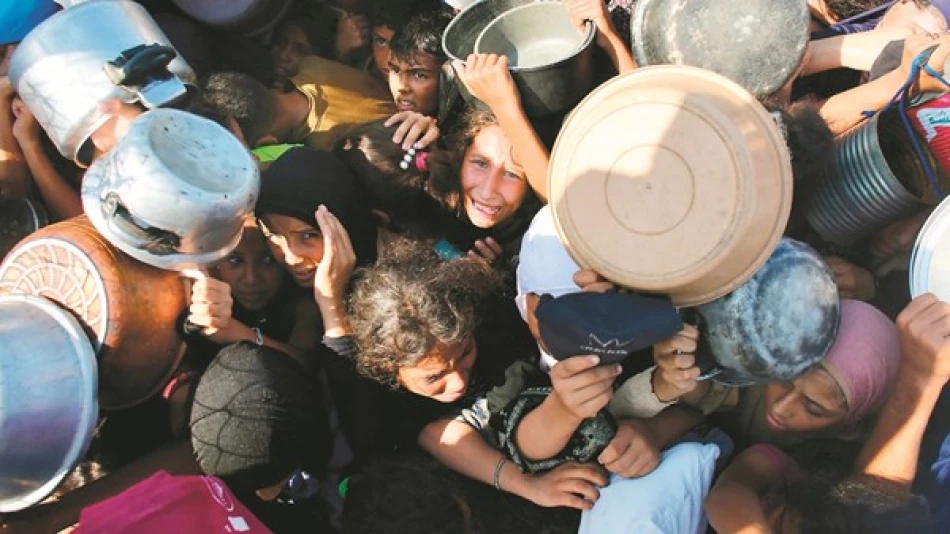
Heartbreaking Tragedy: 21 Children Perish from Starvation in Gaza Within 72 Hours
Gaza's Starvation Crisis: 21 Children Die in 72 Hours as Humanitarian System Collapses
Gaza's humanitarian catastrophe has reached a horrific new milestone, with 21 children dying from hunger and malnutrition in just three days, bringing the total death toll from starvation to over 100 Palestinians since Israel's blockade began. The crisis exposes the complete breakdown of international humanitarian frameworks when warfare meets siege tactics, turning basic survival into a deadly gamble for 2.3 million trapped civilians.
The Arithmetic of Starvation
Dr. Mohammed Abu Salamiya, director of Gaza's Al-Shifa Medical Complex, delivered stark statistics that reveal the scope of the crisis: 900,000 children in Gaza are experiencing hunger, with 70,000 having entered acute malnutrition stages. Of the 101 people who have died from starvation since the war began, 80 were children—most in recent weeks as conditions deteriorated rapidly.
"We are heading toward terrifying numbers of deaths due to the starvation that Gaza's residents are experiencing," Abu Salamiya warned, highlighting how medical professionals are witnessing unprecedented levels of preventable deaths in what was once a functioning healthcare system.
When Seeking Food Becomes Fatal
The UN High Commissioner for Human Rights documented a disturbing pattern: over 1,000 people have been killed while attempting to access food aid. According to their July 21 report, 766 died near Gaza humanitarian sites, while 288 were killed near UN and international aid convoys—all attributed to Israeli military action.
This transforms the basic human act of seeking sustenance into a life-threatening decision, effectively weaponizing hunger in ways that violate fundamental principles of international humanitarian law. The statistics suggest a systematic targeting of food distribution points, making aid delivery not just difficult but deadly.
Healthcare Workers: Saving Lives While Starving
The crisis has created an impossible paradox for Gaza's medical system. Dr. Fadl Naeem, director of Gaza's Baptist Hospital, described medical staff who are "starving while deprived of food, sleep, and rest" yet continue treating patients as their own bodies deteriorate.
Even UN staff are collapsing from hunger, with UNRWA communications director Juliette Touma reporting that UN employees in Gaza are fainting from starvation. This represents an unprecedented breakdown in the international humanitarian system's ability to protect even its own personnel while delivering aid.
The Blockade Economics
Israel maintains total control over all aid supplies entering the war-devastated territory, creating a bottleneck that has proven lethal. UNRWA reports having 6,000 trucks loaded with food, medicine, and hygiene supplies waiting for Israeli permission to enter Gaza—a stockpile that could immediately alleviate the crisis if allowed through.
This level of supply control in modern conflict zones recalls historical sieges, but with contemporary implications for international law and humanitarian principles. The deliberate restriction of food aid to civilian populations constitutes collective punishment under Geneva Convention definitions.
A System's Death Throes
UN Secretary-General António Guterres described witnessing "the death throes of a humanitarian system built on humanitarian principles" that has been "deprived of working conditions, deprived of the space needed to provide aid, deprived of the safety to save lives."
His characterization of Gaza as a "horror movie" where "famine is knocking on every door" reflects how this crisis transcends typical humanitarian emergencies. It represents a fundamental challenge to the post-World War II international order's ability to protect civilian populations during conflict.
Implications Beyond Gaza
This crisis establishes dangerous precedents for how siege warfare can be conducted in the 21st century while maintaining international relationships. The systematic restriction of food aid, combined with targeting of distribution points, creates a blueprint that could be replicated in other conflicts where civilian populations become strategic targets.
The international community's limited response also signals to other actors that such tactics may not trigger meaningful intervention, potentially encouraging similar approaches in future conflicts. Gaza has become a testing ground for how far modern warfare can push civilian suffering before triggering effective international action.
Most Viewed News

 Layla Al Mansoori
Layla Al Mansoori






